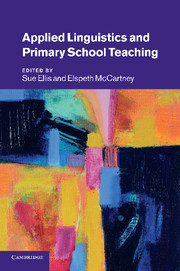Book contents
- Frontmatter
- Contents
- List of figures
- List of tables
- Notes on contributors
- Preface
- Editors' notes and conventions
- Introduction
- Part I Policy and diversity in the twenty-first-century primary school
- Introduction to Part I
- 1 The control of language or the language of control? Primary teachers' knowledge in the context of policy
- 2 Working with children who speak English as an additional language: an Australian perspective on what primary teachers need to know
- 3 Preparing for diversity: the alternatives to ‘linguistic coursework’ for student teachers in the USA
- 4 Supporting children with speech, language and communication needs
- 5 Foreign language teaching in the primary school: meeting the demands
- Part II The range and focus of applied linguistics research
- Part III Empowering teachers and teachers' use of knowledge
- References
- Index
5 - Foreign language teaching in the primary school: meeting the demands
Published online by Cambridge University Press: 26 April 2011
- Frontmatter
- Contents
- List of figures
- List of tables
- Notes on contributors
- Preface
- Editors' notes and conventions
- Introduction
- Part I Policy and diversity in the twenty-first-century primary school
- Introduction to Part I
- 1 The control of language or the language of control? Primary teachers' knowledge in the context of policy
- 2 Working with children who speak English as an additional language: an Australian perspective on what primary teachers need to know
- 3 Preparing for diversity: the alternatives to ‘linguistic coursework’ for student teachers in the USA
- 4 Supporting children with speech, language and communication needs
- 5 Foreign language teaching in the primary school: meeting the demands
- Part II The range and focus of applied linguistics research
- Part III Empowering teachers and teachers' use of knowledge
- References
- Index
Summary
Introduction
On the continent of Europe the English language dominates, so much so that I once observed an English lesson in Spain, even though I could see France out of the classroom window. If you are a teacher in most of continental Europe, then you are usually introducing children to English as part of a continuing journey of developing linguistic competence in that language, usually from age 7 through to the end of secondary education, based on the Council of Europe's (2007) Common European Framework of Reference for Languages (CEFR). For teachers in the English-speaking countries of Britain and Ireland, and in some instances in continental Europe, other foreign languages are taught and teaching Modern Languages in Primary Schools (MLPS) means different things, dependent on the model adopted. As stated in the introduction to Part I, primary teachers are often teaching a language in which they are not fluent and which they have not studied to degree level, and where children have very limited exposure to the language outside the school. This means that the purposes and models of learning require detailed consideration, and the teacher's own learning will require support. The experience of Scotland is the main example considered here.
Models of language learning
Johnstone (1994) identified five models for teaching Modern Languages in Primary Schools (MLPS):
awareness
encounter
subject teaching
embedding
immersion.
Language awareness is where children are introduced to different languages with a view to showing them how language works rather than developing specific competence within one or more languages.
- Type
- Chapter
- Information
- Applied Linguistics and Primary School Teaching , pp. 64 - 74Publisher: Cambridge University PressPrint publication year: 2011
- 2
- Cited by

